Estimation of Ambient Dose Equivalent Rate Distribution Map Using Walking Survey Technique in Hirosaki City, Aomori, Japan
Abstract
1. Introduction
2. Materials and Methods
2.1. Outline and Operation of Walking Survey Technique
2.2. In Situ Gamma Pulse-Height Distribution
2.3. Survey Areas
3. Results and Discussions
3.1. Body-Shielding Correction Factor
3.2. Ambient Dose Equivalent Rate Conversion Factor
3.3. Distribution of Ambient Dose Equivalent Rate
3.4. In Situ Gamma-Ray Pulse-Height Distribution
3.5. Comparison of Dose Rate Distribution Maps between Walking Survey and Spot Measurements
3.6. Comparison of Operation Time between Daytime and Nighttime
4. Conclusions
Author Contributions
Funding
Institutional Review Board Statement
Informed Consent Statement
Data Availability Statement
Conflicts of Interest
Appendix A
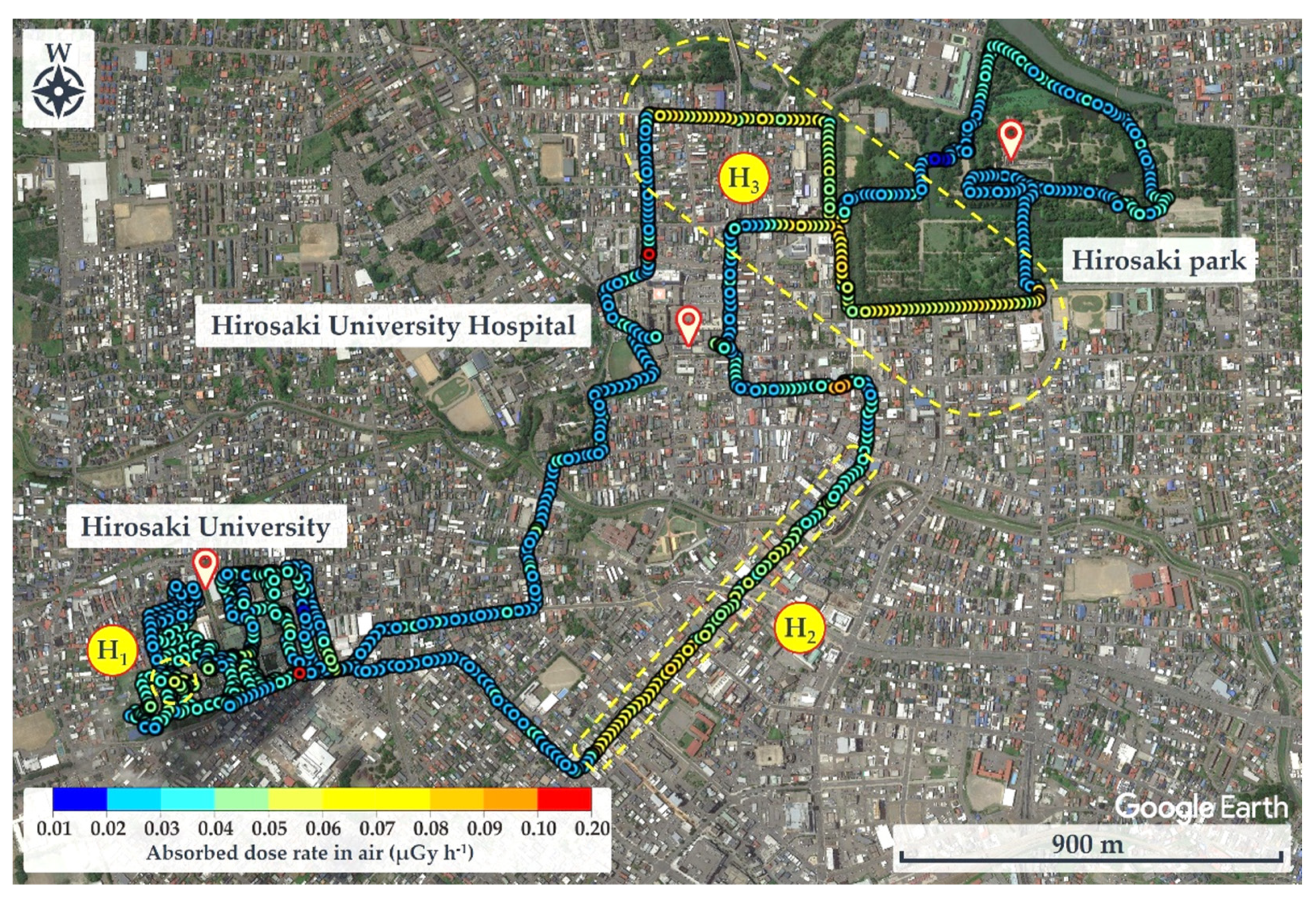
References
- Tamari, Y.; Kuroda, Y.; Miyagawa, R.; Nawa, K.; Sakumi, A.; Sakata, N.; Mizushima, N.; Sakura, O.; Iwamitsu, Y.; Takemura, K.; et al. A Report That Fukushima Residents Are Concerned about Radiation from Land, Food and Radon. J. Radiat. Res. 2016, 57, 418–421. [Google Scholar] [CrossRef]
- Yoshino, H.; Obara, H.; Maeda, T.; Yamada, A.; Watanabe, K.; Hosoda, M.; Sorimachi, A.; Ishikawa, T.; Tokonami, S. An Investigation of Gamma-Ray Dose Rate in the Central Area of Hirosaki City, Japan. Radiat. Emerg. Med./Hirosaki Univ. 2013, 2, 72–76. [Google Scholar]
- Hosoda, M.; Fukui, Y.; Pornnumpa, C. Absorbed Dose Rate in Air at the Bunkyo-Cho Campus of Hirosaki University. Radiat. Emerg. Med./Hirosaki Univ. 2014, 3, 59–62. [Google Scholar]
- Sanusi, M.S.M.; Ramli, A.T.; Hassan, W.M.S.W.; Lee, M.H.; Izham, A.; Said, M.N.; Wagiran, H.; Heryanshah, A. Assessment of Impact of Urbanisation on Background Radiation Exposure and Human Health Risk Estimation in Kuala Lumpur, Malaysia. Environ. Int. 2017, 104, 91–101. [Google Scholar] [CrossRef] [PubMed]
- Inoue, K.; Fukushi, M.; Van Le, T.; Tsuruoka, H.; Kasahara, S.; Nimelan, V. Distribution of Gamma Radiation Dose Rate Related with Natural Radionuclides in All of Vietnam and Radiological Risk Assessment of the Built-up Environment. Sci. Rep. 2020, 10, 1–14. [Google Scholar] [CrossRef]
- Omori, Y.; Sorimachi, A.; Gun-Aajav, M.; Enkhgerel, N.; Oyunbolor, G.; Palam, E.; Yamada, C. Elevation of Gamma Dose Rate by Construction of the Asian Highway 3 (AH3) between Ulaanbaatar and Sainshand, Mongolia. Radiat. Prot. Dosim. 2019, 184, 127–134. [Google Scholar] [CrossRef]
- Omori, Y.; Sasaki, R.; Otsuki, Y.; Sorimachi, A.; Ishikawa, T. Walking Survey Technique for Ambient Gamma Dose Rate Measurement Established in Fukushima Medical University. J. Nucl. Sci. Technol. 2022, 59, 1061–1070. [Google Scholar] [CrossRef]
- Wessel, P.; Smith, W.H.F.; Scharroo, R.; Luis, J.; Wobbe, F. Generic Mapping Tools: Improved Version Released. Eos Trans. Am. Geophys. Union 2013, 94, 409–410. [Google Scholar] [CrossRef]
- Radiation Earth Science Laboratory. Introduction of 49×49 Response Matrix for Environment Gamma Ray Analysis. (Tentative Translation). Available online: http://www1.s3.starcat.ne.jp/reslnote/YONQ.pdf (accessed on 21 October 2022).
- Minato, S. Diagonal Elements Fitting Technique to Improve Response Matrixes for Environmental Gamma Ray Spectrum Unfolding. Radioisotopes 2001, 50, 463–471. [Google Scholar] [CrossRef] [PubMed]
- Minato, S. Response Matrix of a 3″phi x 3″ NaI(Tl) Scintillator for Environmental Gamma Radiation Analysis. Nagoya Kogyo Gijutsu Shikensho Hokoku Jpn. 1978, 27, 12. [Google Scholar]
- Ramzaev, V.; Bernhardsson, C.; Barkovsky, A.; Romanovich, I.; Jarneborn, J.; Mattsson, S.; Dvornik, A.; Gaponenko, S. A Backpack γ-Spectrometer for Measurements of Ambient Dose Equivalent Rate, H˙∗(10), from 137Cs and from Naturally Occurring Radiation: The Importance of Operator Related Attenuation. Radiat. Meas. 2017, 107, 14–22. [Google Scholar] [CrossRef]
- Yajima, K.; Kurihara, O.; Ohmachi, Y.; Takada, M.; Omori, Y.; Akahane, K.; Kim, E.; Torikoshi, M.; Yonehara, H.; Yoshida, S.; et al. Estimating Annual Individual Doses for Evacuees Returning Home to Areas Affected by the Fukushima Nuclear Accident. Health Phys. 2015, 109, 122–133. [Google Scholar] [CrossRef] [PubMed]
- Development and Sales of Radiation Measuring Instruments EMF211 Type Gamma Ray Spectrometer Air Dose Measurement System NaI(Tl). Available online: https://www.emf-japan.com/emf/emf211_airdose.html (accessed on 27 September 2022).
- Omori, Y.; Sorimachi, A.; Ishikawa, T. Measurement of Gamma Radiation at Junior High School Sites in Fukushima City. Radiat. Environ. Med. 2018, 7, 21–27. [Google Scholar]
- Ramzaev, V.; Barkovsky, A. On the Relationship between Ambient Dose Equivalent and Absorbed Dose in Air in the Case of Large-Scale contaminationof the Environment by Radioactive Cesium. Radiatsionnaya Gygiena Radiat. Hyg. 2015, 8, 6–32. [Google Scholar]
- The United Nations Scientific Committee on the Effects of Atomic Radiation. Sources and Effects of Ionizing Radiation: United Nations Scientific Committee on the Effects of Atomic Radiation: UNSCEAR 2000 Report to the General Assembly, with Scientific Annexes Volume I: Sources United Nations; The United Nations Scientific Committee on the Effects of Atomic Radiation: Vienna, Austria, 2010. [Google Scholar]
- Furukawa, M.; Shingaki, R. Terrestrial Gamma Radiation Dose Rate in Japan Estimated before the 2011 Great East Japan Earthquake. Medicine 2012, 1, 11–16. [Google Scholar]
- Hosoda, M.; Inoue, K.; Oka, M.; Omori, Y.; Iwaoka, K.; Tokonami, S.; Obuchi, O. Environmental Radiation Monitoring and External Dose Estimation in Aomori Prefecture after the Fukushima Daiichi Nuclear Power Plant Accident Management Division, Japan Nuclear Fuel Limited; 4-108 Aza. Jpn. J. Health Phys 2016, 51, 41–50. [Google Scholar] [CrossRef]
- Iyogi, T.; Ueda, S.; Hisamatsu, S.; Kondo, K.; Haruta, H.; Katagiri, H.; Kurabayashi, M.; Nakamura, Y.; Tsuji, N. Environmental Gamma-Ray Dose Rate in Aomori Prefecture, Japan. Health Phys. 2002, 82, 521–526. [Google Scholar] [CrossRef]
- Mason, B.; Moore, C.B. Principles of Geochemistry, 4th ed.; Wiley: New York, NY, USA, 1982. [Google Scholar]
- Rudnick, R.L.; Gao, S. Composition of the Continental Crust. Treatise Geochem. 2003, 3–9, 1–64. [Google Scholar] [CrossRef]
- Faure, G. Principles of Isotope Geology, 2nd ed.; Wiley: New York, NY, USA, 1986. [Google Scholar]
- Menager, M.T.; Heath, M.J.; Ivanovich, M.; Montjotin, C.; Barillon, C.R.; Camp, J.; Hasler, S.E. Migration of Uranium from Uranium-Mineralised Fractures into the Rock Matrix in Granite: Implications for Radionuclide Transport around a Radioactive Waste Repository. In Proceedings of the 4th International Conference of Chemistry and Migration Behaviour of Actinides and Fission Products in the Geosphere, Charleston, SC, USA, 12–17 December 1993; pp. 47–83. [Google Scholar]
- Yousef, H.A.; Korany, K.A.; Mira, H.I.; Hassan, S.F.; Saleh, G.M. The Annual Effective Dose of Granite Rock Samples Using Alpha Track Detector. J. Radiat. Res. Appl. Sci. 2019, 12, 112–117. [Google Scholar] [CrossRef]
- Monzen, S.; Hosoda, M.; Tokonami, S.; Osanai, M.; Yoshino, H.; Hosokawa, Y.; Yoshida, M.A.; Yamada, M.; Asari, Y.; Satoh, K.; et al. Individual Radiation Exposure Dose Due to Support Activities at Safe Shelters in Fukushima Prefecture. PLoS ONE 2011, 6, e27761. [Google Scholar] [CrossRef] [PubMed]
- Shimo, M.; Yamaki, K.; Tsujimo, T.; Okamoto, K.; Yoshimoto, T.; Kojima, H.; Mizuma, M. The Influence of the Concentration of Atmospheric Radon Decay Products on the Environmental Radiation Dose Rate. Jpn. J. Health Phys. 2007, 42, 156–165. [Google Scholar] [CrossRef][Green Version]
- ICRP. Conversion Coefficients for Use in Radiological Protection against External Radiation; ICRP Publication: London, UK, 1996; Volume 26. [Google Scholar]
- Yoshidai, H.; Aika, M.; Iki, A.; Ibuki, Y.; Goto, R. Fluctuation Factors of Ambient Dose Rates in the Vicinity of Hamaoka Nuclear Power Plant. Radioisotopes 2004, 53, 405–413. [Google Scholar] [CrossRef][Green Version]



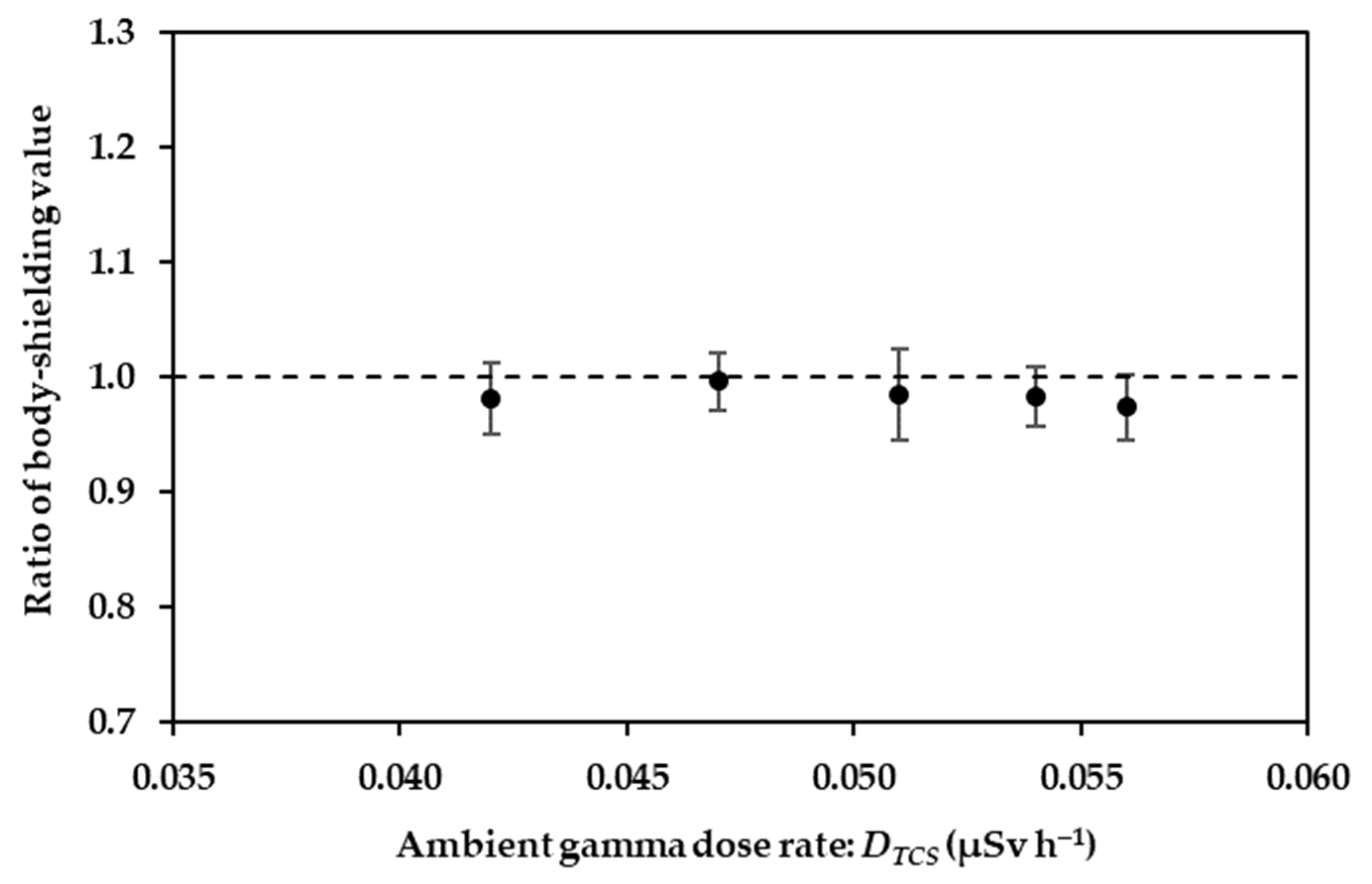


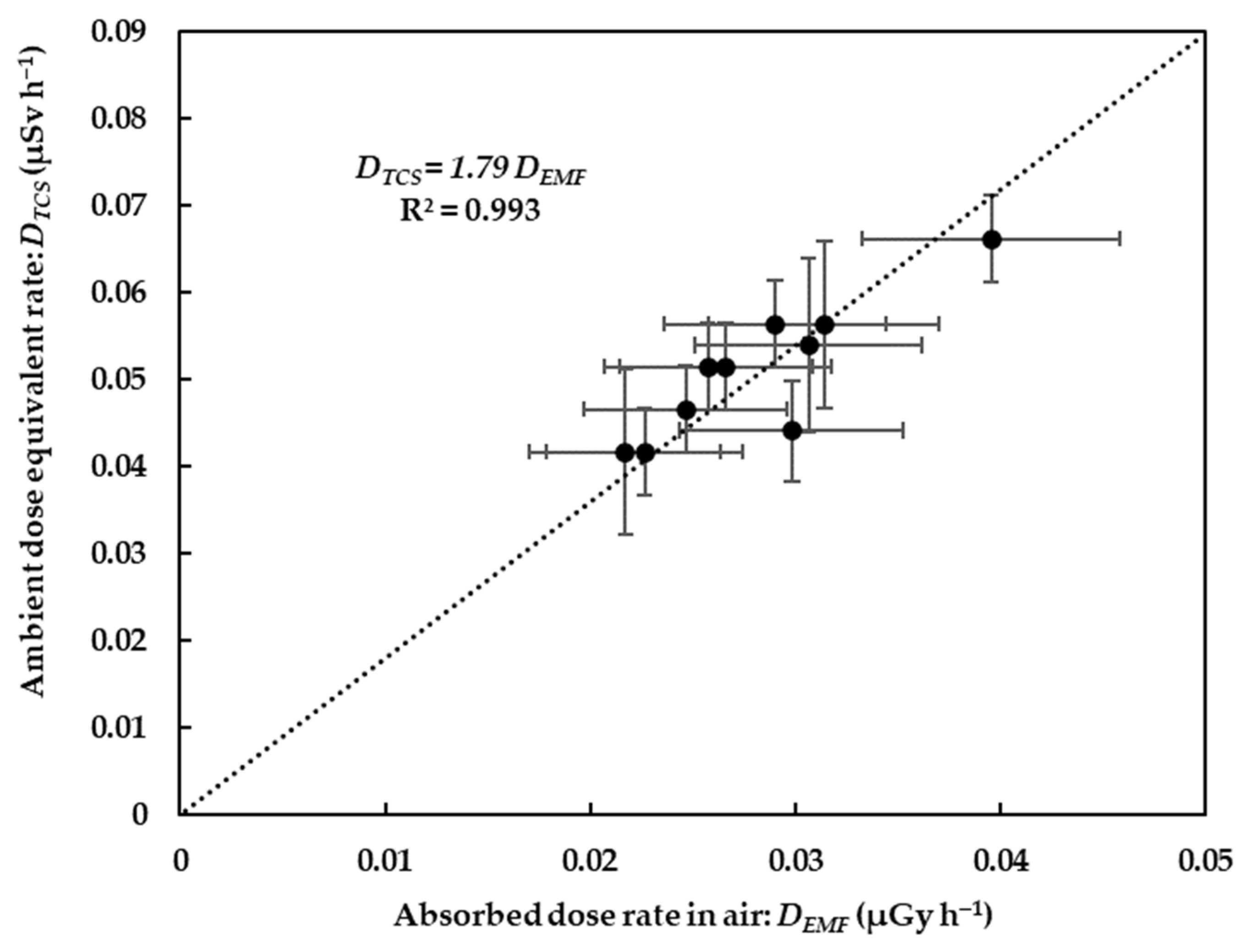

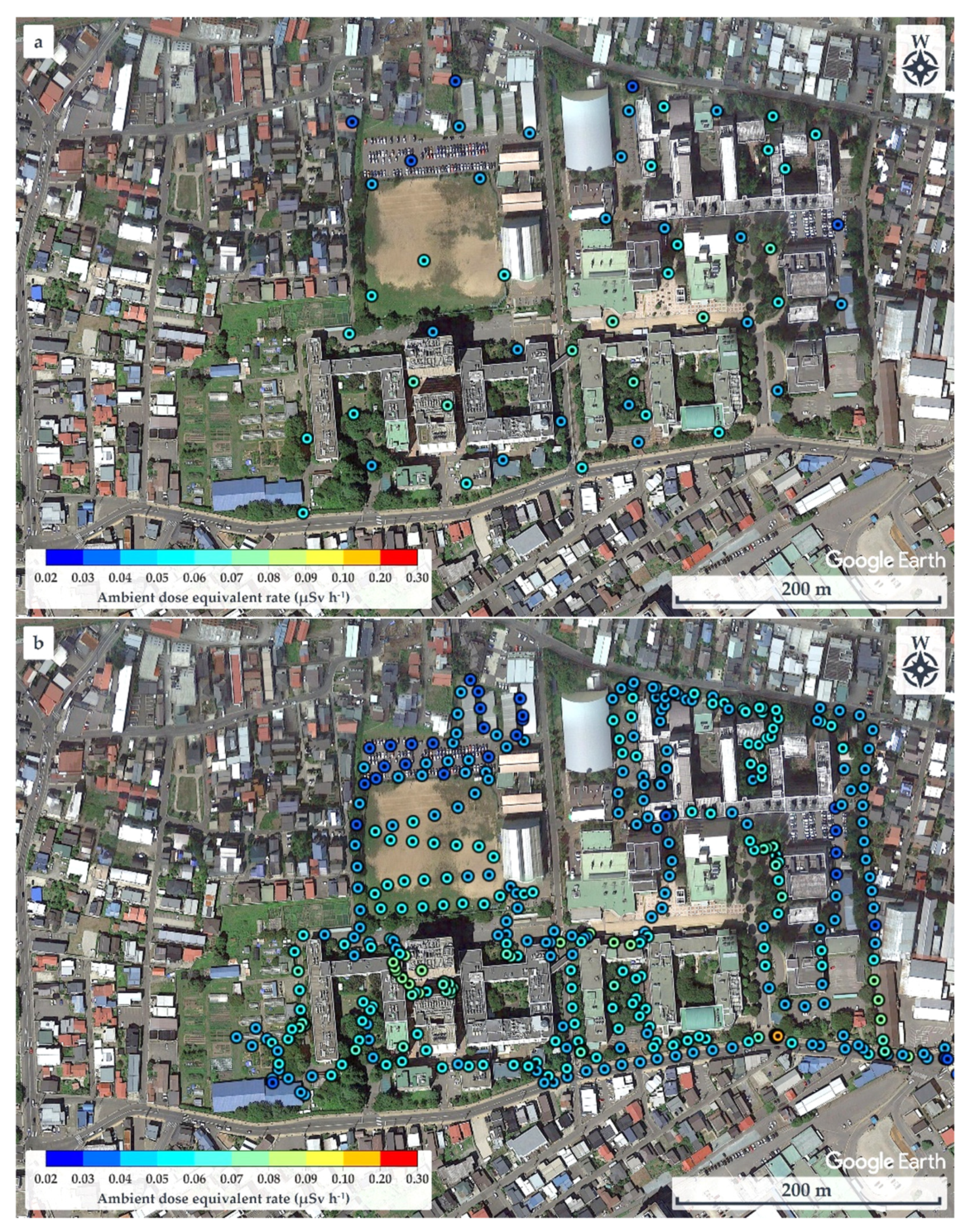
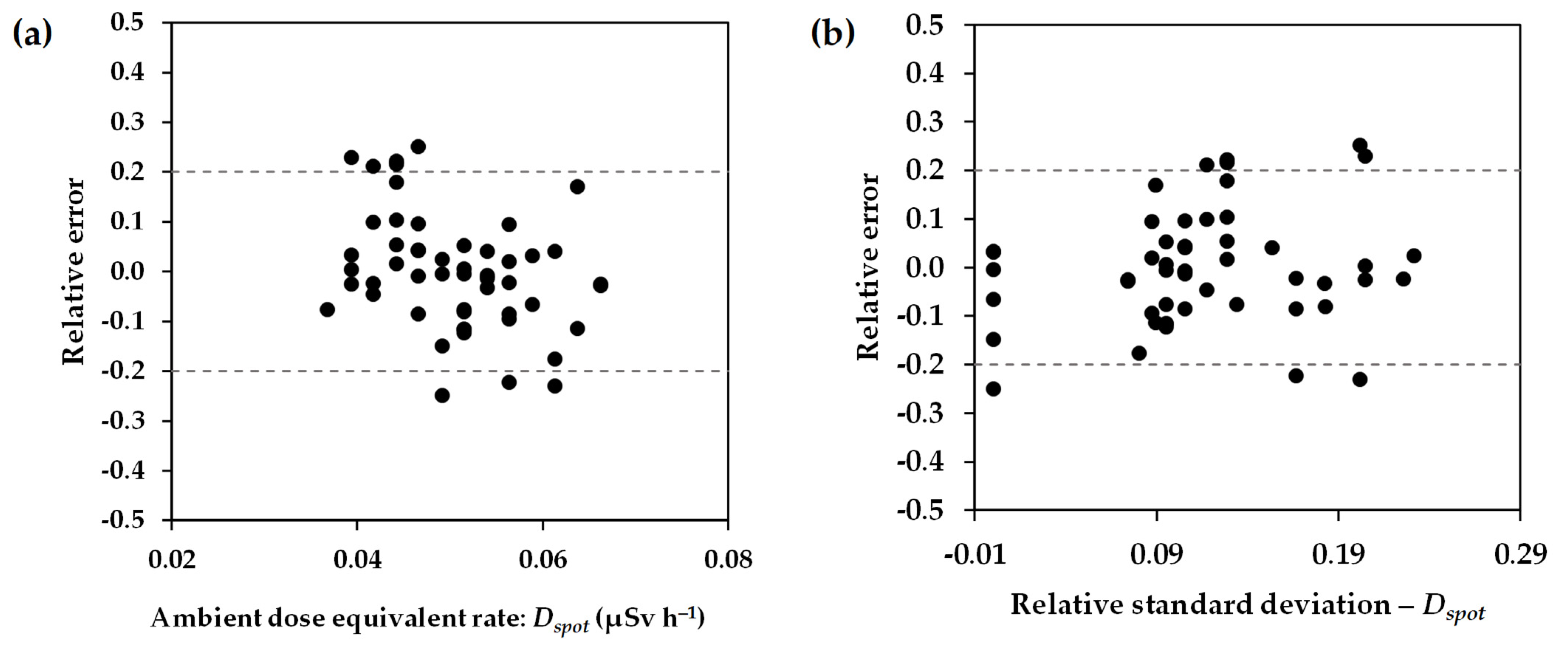
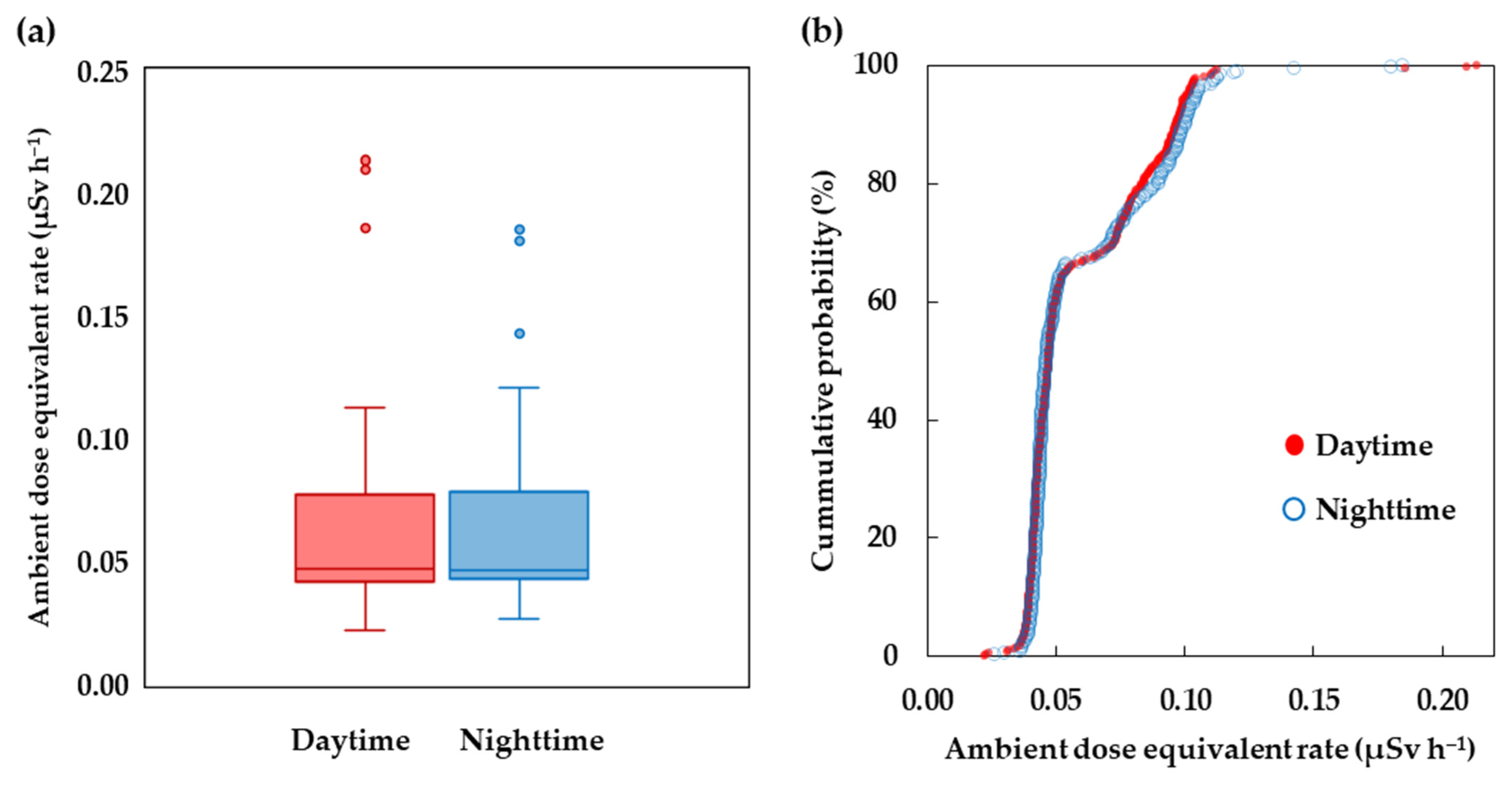
| Location | Ambient Dose Equivalent Rate (µSv h−1) | Net Count Rate (cpm) | Surface Activity (mBq cm−2) | Figure | |
|---|---|---|---|---|---|
| At 0.5 cm | At 100 cm | ||||
| A | 0.144 | 246 ± 55 | 91 ± 18 | 50 ± 11 | 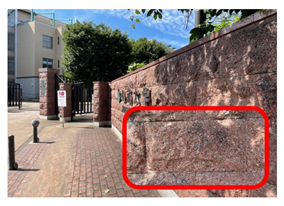 |
| B | 0.213 | 172 ± 12 | 110 ± 7 | 35 ± 2 | 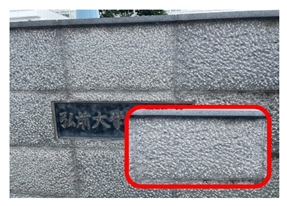 |
| C | 0.125 | 179 ± 26 | 89 ± 11 | 36 ± 5 | 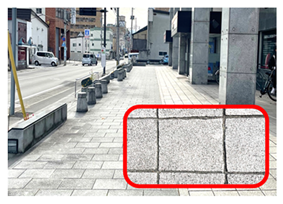 |
| H2 | 0.108 | 188 ± 62 | 86 ± 22 | 38 ± 13 | 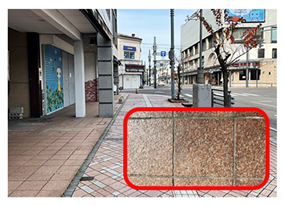 |
| H3 | 0.113 | 188 ± 11 | 75 ± 9 | 38 ± 2 | 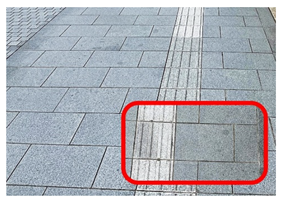 |
Disclaimer/Publisher’s Note: The statements, opinions and data contained in all publications are solely those of the individual author(s) and contributor(s) and not of MDPI and/or the editor(s). MDPI and/or the editor(s) disclaim responsibility for any injury to people or property resulting from any ideas, methods, instructions or products referred to in the content. |
© 2023 by the authors. Licensee MDPI, Basel, Switzerland. This article is an open access article distributed under the terms and conditions of the Creative Commons Attribution (CC BY) license (https://creativecommons.org/licenses/by/4.0/).
Share and Cite
Poltabtim, W.; Musikawan, S.; Thumwong, A.; Omori, Y.; Kranrod, C.; Hosoda, M.; Saenboonruang, K.; Tokonami, S. Estimation of Ambient Dose Equivalent Rate Distribution Map Using Walking Survey Technique in Hirosaki City, Aomori, Japan. Int. J. Environ. Res. Public Health 2023, 20, 2657. https://doi.org/10.3390/ijerph20032657
Poltabtim W, Musikawan S, Thumwong A, Omori Y, Kranrod C, Hosoda M, Saenboonruang K, Tokonami S. Estimation of Ambient Dose Equivalent Rate Distribution Map Using Walking Survey Technique in Hirosaki City, Aomori, Japan. International Journal of Environmental Research and Public Health. 2023; 20(3):2657. https://doi.org/10.3390/ijerph20032657
Chicago/Turabian StylePoltabtim, Worawat, Saowarak Musikawan, Arkarapol Thumwong, Yasutaka Omori, Chutima Kranrod, Masahiro Hosoda, Kiadtisak Saenboonruang, and Shinji Tokonami. 2023. "Estimation of Ambient Dose Equivalent Rate Distribution Map Using Walking Survey Technique in Hirosaki City, Aomori, Japan" International Journal of Environmental Research and Public Health 20, no. 3: 2657. https://doi.org/10.3390/ijerph20032657
APA StylePoltabtim, W., Musikawan, S., Thumwong, A., Omori, Y., Kranrod, C., Hosoda, M., Saenboonruang, K., & Tokonami, S. (2023). Estimation of Ambient Dose Equivalent Rate Distribution Map Using Walking Survey Technique in Hirosaki City, Aomori, Japan. International Journal of Environmental Research and Public Health, 20(3), 2657. https://doi.org/10.3390/ijerph20032657









